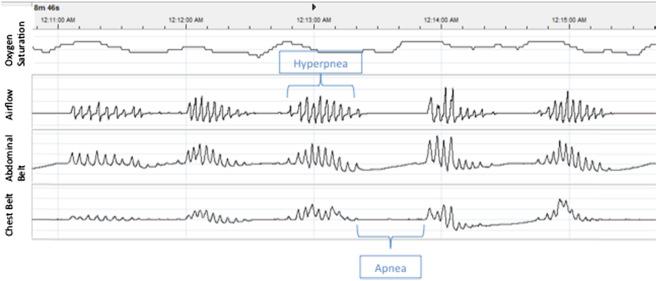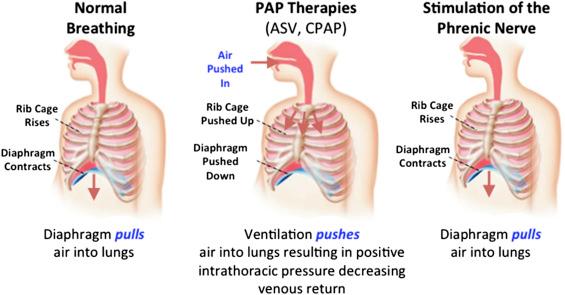Physical Address
304 North Cardinal St.
Dorchester Center, MA 02124
Dr. Abraham has received consulting fees from Respicardia. Dr. Germany is an employee of Respicardia.
Central sleep apnea (CSA) is a disorder in which the brain fails to send appropriate signals to the respiratory muscles to breathe, resulting in a cyclical pattern of breathing with rapid, deep breathing followed by periods of shallow or absent breathing ( ). This pattern of breathing develops due to a delay in the brain recognizing and responding to changes in blood gas carbon dioxide ( ). These periods of absent (apnea) or shallow breathing (hypopnea) can be very long and typically continue once started until the patient arouses ( Fig. 110.1 ). Thus, patients may have 30 s apneas every minute resulting in 60 of these events/hour. This metric, the number of apneas and hypopneas per hour, is termed the apnea hypopnea index (AHI). Each of these episodes results in a drop in oxygen and an arousal to a lighter stage of sleep. This results in disrupted breathing and exacerbation of any underlying medical condition, as well as daytime sleepiness, fatigue, and poor quality of life ( ).

CSA typically occurs in patients with comorbidities such as heart failure and atrial fibrillation which typically are associated with increased sympathetic drive ( ). Elevations in sympathetic drive appear to be one of the factors which can trigger the disease ( ). Injuries to the brain itself also can trigger CSA as is seen in patients with hypoxic brain injury and stroke ( ). Patients may attribute their symptoms to their underlying comorbidity, so a high index of suspicion needs to be maintained ( ). As many as 40% of heart failure patients and 30% of atrial fibrillation patients have CSA when tested ( ).
CSA is diagnosed by a sleep study either in the sleep lab, polysomnography (PSG), or at home, polygraphy. Based on current guidelines, the sleep study is diagnostic for CSA if respiratory monitoring demonstrates at least three consecutive cycles of crescendo-decrescendo change in breathing amplitude and one or both of the following: (1) five or more CSAs or hypopneas per sleep hour and/or (2) cyclical crescendo-decrescendo breathing ≥10 consecutive minutes. As noted, CSA severity commonly is described by the AHI, defined as the number of apnea and hypopnea events per hour. CSA is diagnosed when the majority of the events are central ( ).
When the brain typically initiates a breath, signals are sent to the respiratory muscles of the chest, upper airway, and diaphragm. The largest muscle in this group is the diaphragm, which is innervated by the phrenic nerves on each side. This muscle contracts, pulling downward on the lungs and creating negative inspiratory pressure thus pulling air into the lungs. Expiration is a passive process with the diaphragm and other respiratory muscles in a relaxing state. Thus, the lungs are in a near constant state of movement, stabilizing blood gas levels and maintaining appropriate pH levels ( ).
In CSA, each delayed breathing cycle leads to hypoxia and an arousal to a lighter stage of sleep. This results in higher carbon dioxide levels and changes in the acid–base balance. In addition, each arousal leads to a burst of sympathetic activity with its associated increase in norepinephrine release ( ). Therefore, each cycle causes discrete injury in the form of inflammation, elevated sympathetic activity, pulmonary hypertension, and ischemia. Results from these injuries are widespread and include ischemia, inflammation, peripheral vasoconstriction, both ventricular and atrial arrhythmias, and in multiple studies, almost double the risk of death ( ).
The chronic effects of CSA are most evident when examining the outcomes of patients with comorbid conditions such as heart failure (HF). Mortality doubles in HF patients with CSA compared to those without (50% at 5 years in the untreated CSA HF population compared to approximately 25% in HF patients without CSA) ( ). In addition, CSA is an independent predictor of rehospitalization in HF patients demonstrating a 50% readmission rate at 6 months with 25% having multiple hospitalizations ( ). CSA is also an independent predictor of ventricular arrhythmias and appropriate ICD shocks in patients with ICDs ( ). CSA is clearly detrimental to patients and, based on its pathophysiology, reducing the amount of CSA experienced should lead to significant beneficial effects.
In addition to the adverse effects of hypoxia and norepinephrine release, CSA severely disturbs sleep quality. Patients with CSA typically get less than 5 h of sleep and very little rapid eye movement sleep ( ). Without adequate rest, muscle and tissue recovery decreases and cognitive function is affected resulting in poor work performance and reaction time. Decreased sleep time even without sleep apnea can lead to an increase in car wrecks, falls, and an increase in blood pressure and cardiovascular events ( ).
Even with the clearly detrimental long-term effects of CSA, few treatment options have been developed specifically to treat CSA. Medications such as acetazolamide and theophylline have been studied in small trials ( ). Oxygen has been used to improve hypoxia, but fails to improve arousals and the associated norepinephrine release ( ). Inhaled carbon dioxide and medications have shown short-term benefits in small trials, but lack any long-term randomized data ( ). Most commonly, positive airway pressure therapies have been used to treat CSA as this is the most common therapy used to treat obstructive sleep apnea (OSA) in the sleep laboratory.
Positive airway therapies were initially designed to open closed airways in the treatment of OSA. These systems utilize a mask and ventilation-type system to blow air into the lungs. This is a positive in OSA, where the pressure keeps the airway open, but in CSA, the airway is open already. The result is an increase in airway pressure, which blows in air, primarily to the upper portion of the lung increasing intrathoracic pressure ( ).
The most common form of these therapies, continuous positive airway pressure (CPAP) does decrease the number of episodes (AHI) in some patients with CSA. However, it can also trigger the development of CSA in some patients with OSA termed CPAP-emergent CSA ( ). A newer form of positive airway pressure therapy termed adaptive servo-ventilation (ASV) was developed to alter the level of pressure based on the needs of the CSA patient. While events are decreased with this therapy, long-term results have been disappointing, resulting in a contraindication to ASV in CSA patients with HF and an ejection fraction ≤45% due to an increase in all-cause and cardiovascular mortality ( ). While there is still debate on the cause of this increase in mortality, it is thought to be due to either the study design or the specific mechanism of action of this device ( ). In the later instance, the increase in intrathoracic pressure resulting from the positive airway pressure is postulated to impair hemodynamics in HF patients with reduced ejection fractions ( ). In contrast to normal breathing, positive airway pressure breathing—by pushing rather than pulling air into the lungs—is nonphysiological in these patients, thus producing the detrimental hemodynamic effects ( Fig. 110.2 ). Even if these therapies can be shown to safely treat CSA, these therapies suffer from poor patient acceptance with only about half of patients who are indicated utilizing therapy over the long term ( ).

A new therapeutic approach was developed to restore the missing signals to the diaphragm to initiate a breath—neurostimulation of the phrenic nerve ( ). This therapy stimulates the gas exchange to stabilize carbon dioxide levels and restore normal breathing. In essence, through phrenic nerve stimulation, the diaphragm is stimulated to contract, thus pulling air into the lungs in a way that is identical to normal breathing physiology. Based on years of safety data from surgically implanted phrenic nerve stimulation systems, a new minimally invasive transvenous approach to the treatment of CSA was developed. This new system was designed to allow placement under conscious sedation, without the need for an open chest, and minimize injury to the nerves.
Historically, stimulation of the phrenic nerve has been effective in the management of patients with ventilator-dependent tetraplegia for more than 30 years, providing stimulation and restoring breathing and tidal volumes in ventilator-dependent patients ( ). In currently implanted devices that stimulate the phrenic nerve, electrodes are surgically placed around both phrenic nerves and attached to a neurostimulator to control breathing ( ). During 36 months of follow up, all patients were shown to be able to physiologically withstand stimulation 24 h a day and there was a reduction in respiratory infections. In individual patients, chronic stimulation of the phrenic nerve has been used for up to 15 years without evidence of long-term nerve injury ( ). Extended use of neurostimulation of the phrenic nerve in respiratory device-dependent patients has been demonstrated to be both safe and effective ( ). Newer methods of implantation utilizing laproscopic techniques have widened the use of the therapy in cases of spinal cord injury with one retrospective multicenter study demonstrating 73% of patients able to be weaned from the ventilator following implantation ( ).
Phrenic nerve stimulation also has been done via leads placed on the diaphragm to stimulate the phrenic nerve (pacing-induced diaphragmatic stimulation – PIDS). Spinal cord injury patients also had success with the approach with only one failure in a patient with prior injury to the phrenic nerve ( ). This approach has been used acutely in patients undergoing bypass surgery which a unique algorithm providing low-frequency stimulation timed to the cardiac cycle. This stimulation improved left ventricular systolic function without causing patients symptoms. This therapeutic approach continues to be studied clinically for ventilated patients.
Become a Clinical Tree membership for Full access and enjoy Unlimited articles
If you are a member. Log in here